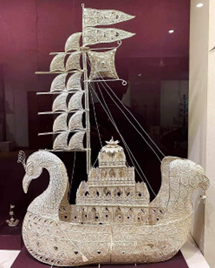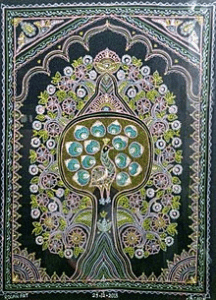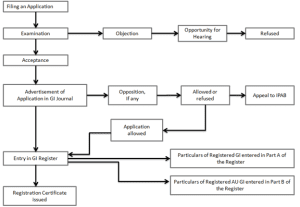TAG: GS 3: ECONOMY
THE CONTEXT: Recently, a number of products has been awarded Geographical Indication tags.
EXPLANATION:
Cuttack Rupa Tarakasi (Silver Filigree) – A Symbol of Craftsmanship and Tradition
- The renowned Cuttack Rupa Tarakasi, known for its exquisite Silver Filigree work, has been granted the prestigious Geographical Indication (GI) tag by the Geographical Indications Registry in Chennai.
- It was filed by the Odisha State Co-operative Handicrafts Corporation Limited and supported by the Department of Textile and Handicrafts, Government of Odisha.
- This acknowledgment recognizes the traditional association of filigree with fine craftsmanship and opulent design in classical jewelry.
- Archaeological evidence suggests the incorporation of filigree into jewelry as early as 3500 BCE in Mesopotamia, persisting today as Telkari work.
- The filing alludes to the possibility of Tarakasi work reaching Cuttack from Persia through Indonesia around 500 years ago, facilitated by sea trade.
- Literary references, such as the story of Ta-Poi, indicate historical maritime activities involving the exchange of jewelry and gems between Kalinga and Indonesia, hinting at Indonesia as a potential origin of Silver Filigree in Odisha.

Banglar Muslin – Bengal’s Traditional Handloom Craft
- Banglar muslin, a traditional handloom craft of Bengal, has secured a Geographical Indication (GI) tag.
- This fine muslin is crafted from cotton threads, spun to maintain tensile strength at counts ranging from 300 to 600, surpassing other cotton products.
Narasapur Crochet Lace Products – Global Acclaim for Intricate Craftsmanship
- Narasapur in West Godavari, Andhra Pradesh, has gained international acclaim for its intricate crochet lace craftsmanship.
- Missionaries introduced crochet skills to Narsapur, making it a prominent center for handmade crocheted lace work.
Kutch Rogan Craft – A Distinctive GI Craft
- Kutch Rogan Craft is among the products awarded the Geographical Indication (GI) tag.
- Kutch Rogan Craft, also known as Rogan painting, is a unique and beautiful art form practiced in the Kutch region of Gujarat, India.
- It involves the creation of intricate designs and patterns on fabrics using a special resist painting technique.

Other Distinguished GI-Tagged Products:
Ratlam Riyawan Lahsun (Garlic) – Madhya Pradesh’s Culinary Gem
- Origin: Ratlam Riyawan Lahsun is named after Riyawan village in the Ratlam district of Madhya Pradesh, India.
- Culinary Gem: This variety of garlic is renowned for its unique taste, aroma, and medicinal properties, making it a culinary gem in Madhya Pradesh.
Ambaji White Marble – Formed Under Intense Pressure and Heat
- Origin: Ambaji White Marble comes from the Ambaji region, known for its marble quarries, situated in the state of Gujarat, India.
- It is formed through the re-crystallization of limestone under the earth’s crust due to intense pressure and heat.
- Ambaji White Marble is highly valued for its purity, luster, and suitability for various artistic and architectural applications.
Hyderabad Lac Bangles – Craftsmanship from the City of Pearls
- Hyderabad Lac Bangles are traditional bangles crafted in Hyderabad, Telangana, known as the “City of Pearls.”
- Craftsmanship: These bangles are crafted using lac, a natural resin, and are known for their intricate designs and vibrant colors, reflecting the rich cultural heritage of the region.
Majuli Mask of Assam – Varied Categories Reflecting Cultural Significance
- Majuli Masks are crafted in the Majuli district of Assam, the largest river island in the Brahmaputra River.
- Cultural Significance: These masks, categorized as ‘Mukha bhaona,’ ‘Lotokoi,’ and ‘Cho Mukha,’ play diverse roles in Assamese culture, representing various themes and characters.
Assam Majuli Manuscript Painting – Depicting Hindu Epics and Bhagavata Purana
- Assam Majuli Manuscript Paintings hail from the Majuli district in Assam, India.
- Depiction of Epics: These paintings illustrate stories and chapters taken from Hindu epics like Ramayana, Mahabharata, and the Bhagavata Purana, showcasing the artistic heritage of Assam.
Geographical Indication (GI) tag:
- It came into force with effect from 15th September 2003.
- The Geographical Indication (GI) tag is given to products so that only authorized people can use the popular product’s name.
- It is given to products having a specific geographical origin and qualities or reputation associated with that origin.
- It was given to products related to agriculture, handicrafts, foodstuffs, spirit drinks, and industrial products.
- The first product to receive this tag is Darjeeling Tea.
- The rules and regulations of the GI tag are governed by the WTO’s agreement on trade-related aspects of intellectual property rights.
- In India, GI products are governed by the Geographical Indications of Goods (Registration and Protection) Act, 1999.
- This tag is valid for 10 years and can be renewed.
GI Registration:
- In December 1999, Parliament passed the Geographical Indications of Goods (Registration and Protection) Act 1999.
- This Act seeks to provide for the registration and protection of Geographical Indications relating to goods in India.
- This Act is administered by the Controller General of Patents, Designs and Trade Marks, who is the Registrar of Geographical Indications. The Geographical Indications Registry is located at Chennai.
- The Registrar of Geographical Indication is divided into two parts. Part ’A’ consists of particulars relating to registered Geographical indications and Part ‘B’ consists of particulars of the registered authorized users.
- The registration process is similar to both for registration of geographical indication and an authorized user which is illustrated below:


